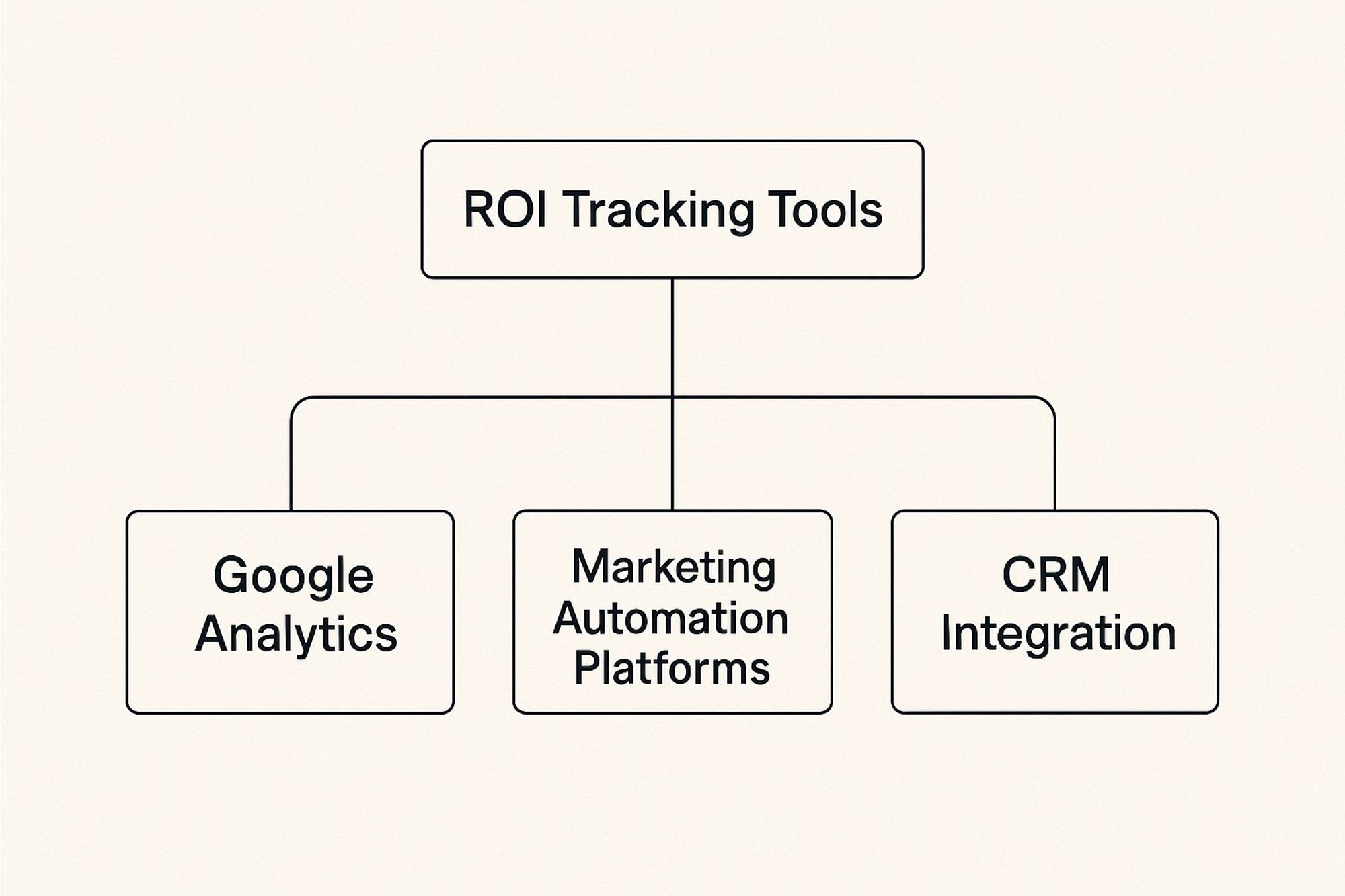Tuesday, July 22, 2025
Measuring Your Content Marketing ROI

Let's be honest, content marketing ROI can feel like one of those fuzzy, hard-to-pin-down metrics. But at its core, it’s actually pretty simple. Content marketing ROI is the measure of how much revenue you earn from your content compared to what you spent creating and promoting it.
Think of it as the ultimate report card for your marketing. If you spend $1 on a blog post, video, or social campaign, ROI tells you exactly how many dollars you get back in return.
Why Measuring Content Marketing ROI Is Non-Negotiable

Creating content without measuring its return is like sailing a ship without a rudder. Sure, you’re moving and putting in the work, but are you actually getting any closer to your destination? Or are you just drifting?
Tracking content marketing ROI is the compass that guides your entire strategy. It’s what turns your marketing from a perceived "cost center" into a predictable revenue engine. When you can directly connect your content to financial results, every blog post and video suddenly has a clear, undeniable purpose.
Before we dive into the "how," let's quickly summarize why this is so critical for any business.
Top Reasons to Measure Your Content ROI
| Reason | Business Impact |
|---|---|
| Budget Justification | Prove the value of your marketing spend and secure more resources by showing a direct return. |
| Strategic Focus | Identify what works (and what doesn't), so you can invest in high-impact content. |
| Improved Performance | Continuously refine your content strategy based on data, not guesswork. |
| Team Alignment | Ensure every piece of content supports measurable business goals, from leads to sales. |
| Prove Your Value | Transform marketing from an expense into a documented driver of revenue and growth. |
Simply put, tracking ROI gives you the data you need to make smarter decisions and grow the business.
Justify Your Budget and Prove Your Value
In any business, budgets are tight. When you can walk into a meeting with hard numbers showing exactly how your content efforts are fueling the bottom line, the entire conversation changes. You're no longer just asking for money; you're demonstrating how an increased investment will generate an even greater return.
The data backs this up. One powerful analysis found that content marketing can deliver an average of $42 in return for every $1 spent—a staggering figure that puts its efficiency on full display. On top of that, 73% of B2B marketers name content as their top strategy for generating leads and sales. If you're curious, you can explore more content marketing statistics to see the full impact for yourself.
Measuring ROI provides the evidence you need to protect your marketing budget during financial reviews and make a compelling case for expansion. It shifts the discussion from "How much does this cost?" to "How much revenue can this generate?"
Sharpen Your Content Focus for Maximum Impact
Measuring ROI isn’t just about justifying your existence; it’s about optimization. When you know which types of content generate the highest returns, you can confidently double down on what works and stop wasting resources on what doesn’t.
This strategic clarity allows you to:
- Allocate Resources Effectively: Funnel your time, talent, and budget into the channels and formats that deliver the goods, whether it’s in-depth blog posts, engaging videos, or lead-generating white papers.
- Refine Your Messaging: Pinpoint which topics and angles resonate most with your highest-value customers, letting you create more content that actually converts.
- Achieve Strategic Alignment: Make sure every single piece of content you create supports a specific, measurable business goal, from building brand awareness to driving direct sales.
Ultimately, tracking your content marketing ROI empowers you to make smarter, data-informed decisions that fuel sustainable growth. It's the critical link that connects your creative efforts to real, tangible business success.
The Fundamental Content Marketing ROI Formula

Calculating your content marketing ROI sounds more intimidating than it actually is. Deep down, the formula is refreshingly simple—in fact, it's the same one every other department uses to figure out if their efforts are actually making money.
Here's the classic calculation you'll want to get familiar with:
[(Return - Investment) / Investment] x 100 = ROI %
Think of this formula as your trusty North Star. To get a useful result, you just need to nail down your two key numbers: the Return and the Investment. Once you have solid figures for both, the math is easy. The final number, shown as a percentage, tells you exactly how much value you’re getting back for every dollar you put in.
Breaking Down Your Investment
First things first, let's tally up your costs. Your "Investment" is the total sum of everything you spend to create, publish, and get eyes on your content. The more thorough you are here, the more accurate your final ROI number will be.
Common costs usually fall into a few buckets:
- Production Costs: This is the most obvious expense. It covers payments to your in-house team (like a portion of their salaries) and any freelancers you hire, such as writers, designers, or video editors.
- Software and Tools: Don't forget the monthly or annual fees for your marketing tech stack. This includes things like SEO tools, project management software, analytics platforms, and content schedulers.
- Distribution and Promotion: Any cash you put behind paid advertising goes here. Think social media boosts, Google Ads, or any other pay-per-click (PPC) campaigns designed to push your content out.
- Overhead: Some marketers even attribute a small slice of general business costs, like office space or utilities, to their content budget. For simplicity, though, most stick to the direct costs.
For instance, if your team uses a specific platform to manage and schedule posts, that's a direct distribution cost. This is a common practice, and you can learn more about how to calculate social media ROI, which follows very similar investment principles.
Don't get paralyzed trying to track every single penny. A good rule of thumb is to capture around 90% of your main costs. That's usually more than enough to make smart, data-backed decisions.
Defining Your Return
Now for the fun part: the "Return." This is where things get interesting because it’s not always a single, straightforward number. While direct revenue is the ultimate prize, the total value your content generates is often much broader.
You can measure this value in a few key ways:
- Direct Sales Revenue: This is the cleanest metric to track. A customer reads a blog post, clicks a link to a product page, and buys something. Your analytics should be able to connect those dots for you.
- Value of New Leads: Not every piece of content is meant to close a sale on the spot. A huge return might be someone downloading a whitepaper or signing up for a demo. You can assign a dollar value to these leads based on how often they typically convert into paying customers.
- Customer Lifetime Value (LTV): Exceptional content doesn't just attract customers; it creates loyal fans who come back again and again. Factoring in the LTV of customers you acquired through content gives you a much richer, long-term picture of your true return.
A Real-World ROI Calculation
Let's walk through an example to make this concrete. Imagine a B2B software company publishes a comprehensive guide to generate new leads.
Investment:
- Content Creation: They paid a freelance writer $800 for the guide.
- Graphic Design: A designer created custom visuals for $200.
- Ad Spend: The company spent $500 promoting the guide on LinkedIn.
- Total Investment: $1,500
Return: The guide was a hit, generating 50 qualified leads who signed up for a product demo. The sales team knows from experience that 10% of these demo leads become paying customers, and each new customer has an average LTV of $4,000.
- Leads Converted: 50 leads x 10% conversion rate = 5 new customers
- Total Return: 5 customers x $4,000 LTV = $20,000
Now, we just plug those numbers into our formula:
[($20,000 - $1,500) / $1,500] x 100
[$18,500 / $1,500] x 100 = 1,233%
The content marketing ROI for this one guide is a staggering 1,233%. This simple math pulls the concept of ROI out of the clouds and turns it into a powerful, practical tool for proving your content's worth.
Identifying the Metrics That Fuel Your ROI
Calculating your content marketing ROI feels a bit like baking a cake. You can't just throw random ingredients in a bowl and hope for the best. To get it right, you need a precise recipe, and in marketing, that means tracking the right metrics.
This isn't about chasing every vanity number you can find. It's about connecting the dots, following the story of how a person goes from a first-time visitor to a loyal customer. Each metric is a clue, a breadcrumb that links your hard work directly to your bottom-line results.
The easiest way I've found to think about this is like a customer journey, broken down into a funnel. This helps you see not just what's happening, but why.
Consumption Metrics: Is Anyone Even Listening?
First things first: are people actually seeing what you’re putting out there? These top-of-funnel metrics are your foundational check. If these numbers are zero, nothing else matters because the rest of your funnel will be completely empty.
Here are the basics to watch:
- Pageviews and Unique Visitors: This is the raw count of eyeballs on your content. It’s the simplest, most fundamental measure of your reach.
- Time on Page: A high average here is a fantastic sign. It tells you your content is actually holding people's attention, suggesting it’s relevant and high-quality.
- Scroll Depth: Are people bailing after the first paragraph? Scroll depth shows you how far down the page they’re getting, giving you a clue about whether your message is compelling from start to finish.
You can pull all of these straight from a tool like Google Analytics. They give you that crucial high-level view of whether you're successfully getting your foot in the door.
Engagement Metrics: Did Your Content Actually Connect?
Okay, so people are seeing your content. The next big question is: did they care? Engagement metrics are where you start to see if your content is truly resonating. It’s one thing to get a click; it’s another to get a reaction.
Engagement is the bridge between someone passively reading and actively showing interest. A share, a comment, or a backlink is a vote of confidence. It's your audience saying, "This was so good, I had to do something about it."
Key engagement metrics to track:
- Social Shares, Likes, and Comments: These are public endorsements. When someone shares your post, they're putting their own reputation on the line, which is a powerful signal. You can learn how to measure social media engagement to see how this feeds your bigger goals.
- Backlinks: This is the gold standard of content authority. When another website links to you, it’s a massive SEO boost and a huge sign of trust.
- Click-Through Rate (CTR): This measures how many people clicked a link in your content, like your call-to-action (CTA). A strong CTR is proof that your offer and your message are perfectly aligned.

This visual really hammers home that you need to pull data from different places—web analytics, marketing platforms, and your CRM—to get the full picture.
To make this even clearer, let's break down the essential metrics you'll be tracking across the entire funnel.
Essential Content Metrics and What They Measure
| Metric Category | Example Metrics | What It Tells You |
|---|---|---|
| Consumption | Pageviews, Time on Page, Scroll Depth | Is your content being found and holding attention at the top of the funnel? |
| Engagement | Social Shares, Backlinks, Click-Through Rate | Is your content compelling enough to provoke an interaction? |
| Lead Generation | Conversion Rate, MQLs/SQLs, Cost Per Lead | Is your content effectively turning anonymous visitors into potential customers? |
| Sales | Customer Acquisition Cost, Attributed Revenue, LTV | Is your content directly contributing to closed deals and long-term business value? |
This table acts as a quick-reference guide, helping you pinpoint which metrics to focus on at each stage of the customer journey.
Lead Generation Metrics: Turning Visitors into Contacts
This is where your content starts paying the bills. Lead generation metrics are the first tangible sign of value, tracking how well you convert anonymous traffic into real, known contacts. These numbers are what start to build the "Return" side of the ROI equation.
Metrics that truly matter here:
- Conversion Rate: The percentage of people who take a specific action, like downloading a guide, signing up for a webinar, or filling out a form.
- Number of Qualified Leads: Let's be honest, not all leads are good leads. Tracking MQLs (Marketing Qualified Leads) or SQLs (Sales Qualified Leads) is what really counts.
- Cost Per Lead (CPL): This simple calculation (Total Spend ÷ Number of Leads) tells you exactly how efficient your content is at generating new contacts.
Sales Metrics: Connecting Content Directly to Cash
Finally, we get to the bottom line. Sales metrics are where the rubber meets the road, tying your content efforts directly to closed deals. This is the ultimate proof of a positive content marketing ROI.
The most critical sales metrics are:
- Customer Acquisition Cost (CAC): What did it cost, in total, to win a new customer through your content? A good customer acquisition cost calculator can be a huge help here.
- Revenue Attributed to Content: With the right tracking in place, you can see exactly which blog posts or videos a customer engaged with before they made a purchase.
- Customer Lifetime Value (LTV): Great content doesn't just get you a single sale; it builds loyalty. The LTV of customers who came through your content shows its powerful, long-term financial impact.
Using Technology for Smarter ROI Measurement

Let's be honest. Trying to manually connect the dots from someone's first blog visit to their final purchase is a nightmare. You’re drowning in data, and juggling spreadsheets is a surefire way to get frustrated—and get your numbers wrong.
This is where technology isn't just helpful; it's your most valuable player. The right tools do more than just automate busywork. They give you the x-ray vision needed to connect your content directly to revenue, turning the fuzzy idea of content marketing ROI into a hard, data-backed science.
The Power of Automation and CRMs
The real magic happens when your tools start talking to each other. When you integrate your content management system (CMS), marketing automation platform, and Customer Relationship Management (CRM) software, you finally get the complete picture of the customer journey.
Think of it like this: your blog post is the first handshake. Your marketing automation platform tracks the entire conversation that follows, and your CRM logs the final deal. When these systems are linked, you see the whole story from start to finish.
This integration lets you:
- Attribute Leads Accurately: Finally, you can pinpoint the exact article, webinar, or social post that brought a new lead into your world.
- Track Every Touchpoint: Follow a prospect as they move through your content, giving you incredible insight into what actually pushes them closer to a sale.
- Calculate Revenue Per Piece: See exactly how much revenue a specific blog post or video influenced. Now you have undeniable proof of its value.
This is the kind of insight that changes everything. You stop guessing which content works and start making decisions based on cold, hard financial data. If you want to dig deeper into what different analytics platforms can do, a good place to start is this comparison of SEMrush vs Google Analytics.
AI's Role in Optimizing and Measuring ROI
Artificial intelligence is adding another incredibly powerful layer to this tech stack. AI tools aren't just for churning out content anymore; they are becoming essential for understanding its impact on a much deeper level.
In fact, the adoption of AI is already making a huge difference. A stunning 68% of businesses report measurable bumps in their returns specifically because of AI. And when you look at the most successful content marketers, 82% of them credit their success to a deep understanding of their audience—something AI is uniquely good at providing.
Here’s how AI is changing the ROI game:
- Hyper-Personalization: AI algorithms can analyze a user's behavior in real time to serve up the most relevant content to them at that moment. This drastically increases engagement and, more importantly, conversion rates.
- Predictive Analytics: By chewing through past performance data, AI can predict which topics and formats are most likely to kill it with your audience and drive the biggest return.
- Advanced Attribution Modeling: AI moves way beyond simplistic "first-touch" or "last-touch" models. It can analyze complex customer journeys to assign credit more accurately across all the content they interacted with. This helps you understand how different pieces, like social media posts, work together. You can also check out our guide on key social media engagement metrics to see how this fits into the bigger picture.
By bringing these technologies into your workflow, you shift ROI measurement from a backward-looking chore into a forward-looking strategy. You’re not just seeing what worked last quarter; you're predicting what will work next quarter, allowing you to invest your time and money with confidence.
Actionable Strategies to Improve Content Marketing ROI
Measuring your ROI is a fantastic start, but it's only half the job. The real goal is to actively improve it. Once you know which content is actually driving results, you can shift from just tracking performance to strategically boosting it. It’s all about making every single piece of content work harder and smarter for your business.
Think of it like a chef who just perfected a new recipe. They don't just stop there. They start brainstorming how to create variations, serve it in new ways, and get the most out of their hit dish. The exact same principle applies to your top-performing content.
Perform a Content Refurbishment
One of the quickest ways to improve your content marketing ROI is to breathe new life into what you already have. Your archives are probably full of older posts with a ton of untapped potential. A "content refurbishment" is all about finding these hidden gems and giving them a modern upgrade.
Tools like Google Search Console are your best friend here. Look for pages that are stuck on the second or third page of Google for valuable keywords. These are your prime candidates because they're so close to driving serious organic traffic.
This report is like a treasure map, pointing you to keywords where a small push could lead to a massive win. By updating these posts with fresh information, better visuals, and stronger on-page SEO, you can often jump to the first page without starting from scratch.
Master the Art of Content Repurposing
Why let a home-run blog post live and die as a single asset? Content repurposing is the art of transforming one high-performing piece into an entire ecosystem of content. This strategy maximizes the return on your initial investment by reaching different audiences across totally different platforms.
A single, well-researched guide can be taken apart and rebuilt into all sorts of formats:
- A Video Summary: Create a short, punchy video that hits the main points for your YouTube audience.
- An Infographic: Distill the key data and steps into a slick, visually appealing infographic that's perfect for Pinterest and social sharing.
- Social Media Updates: Chop up the key takeaways into a series of posts for X, Threads, or LinkedIn.
- A Slide Deck: Turn the main sections into a presentation you can upload to SlideShare to reach a more professional crowd.
This approach amplifies your message without forcing you to constantly reinvent the wheel. It's about squeezing every last drop of value from your best work. And to really get the most out of it, focus on implementing practical content creation tips for visuals that will make each piece pop.
Optimize Your Distribution and CTAs
Your content is only as good as its distribution. A brilliant article that nobody ever sees has an ROI of exactly zero. This is where a sharp focus on social media and crystal-clear calls-to-action (CTAs) becomes absolutely critical for improving your return.
Social media isn't just for engagement anymore; it's a huge driver of ROI. Globally, social networks were responsible for 17.11% of all online sales. Short-form video was the most profitable content type for 71% of video marketers, and user-generated content (UGC) swayed the decisions of a staggering 90% of shoppers.
This data makes it obvious: getting your content onto the right social platforms is non-negotiable. By actively promoting your assets and actually talking with your audience, you drive more traffic and create way more opportunities to convert. To take this even further, check out our guide on how to boost social media engagement and turn those passive viewers into active participants.
Finally, take a hard look at your CTAs. Are they clear? Do they match what the user actually wants to do? A/B test different wording, colors, and placements to see what drives the most clicks and conversions. Sometimes, a tiny tweak to a CTA button can lead to a huge lift in your lead generation and, ultimately, your content marketing ROI.
Even with all the formulas and metrics in the world, some questions about content marketing ROI just keep popping up. It's these tricky, nuanced parts that can make measurement feel like a moving target. But getting a grip on them is the key to setting realistic expectations and finally proving the long-term value of your work.
Let's break down some of the most common hurdles marketers run into.
One of the biggest is simply managing expectations around timing. Unlike a paid ad that gives you an instant (but fleeting) result, content marketing is all about the long game. It's an investment that compounds over time. Think of it less like flipping a light switch and more like planting a tree.
How Long Does It Take to See a Return?
You’re almost certainly not going to see a meaningful return in the first month. Or the second. Real, sustainable ROI from content often takes a good 6-12 months to really kick in. Why so long? Because it takes time for Google to find and index your content, for it to start attracting backlinks, and for your site to build genuine authority on a topic.
Those first few months are all about laying the groundwork. Your content is slowly but surely climbing the search rankings and building momentum. Then, usually around the one-year mark, you hit a tipping point. That's when your older posts start becoming a consistent, reliable engine for traffic and leads, delivering returns long after you made the initial investment.
The patience required for content marketing pays off big time. While paid ads die the second you stop paying, a single high-ranking blog post can generate leads and revenue for years, eventually becoming one of your most profitable assets.
What Is Considered a Good ROI?
Honestly, there’s no magic number for a "good" ROI that works for everyone. It really depends on your industry, your profit margins, and your specific business model. A company selling high-ticket SaaS subscriptions can do just fine with a lower conversion rate compared to an e-commerce store selling t-shirts.
That said, a common rule of thumb is that a 5:1 ratio (which is a 400% ROI) is considered excellent. This means for every $1 you put into content, you get $5 back. Anything over 1:1 means you're in the green, but that 5:1 mark is a sign that you've built a seriously effective and scalable content machine.
How Do You Measure Top-of-Funnel Content?
Okay, this is where a lot of people get stuck. How do you measure the ROI of a "how-to" blog post or a brand awareness video? They almost never lead directly to a sale, so it can feel a bit abstract.
The trick is to assign value to the non-financial conversions and then track how they influence sales down the line.
You can measure the impact of this top-of-funnel content by tracking things like:
- Newsletter Sign-ups: How many new subscribers did a specific post bring in?
- Lead Magnet Downloads: Did that guide drive downloads of your new e-book?
- Assisted Conversions: Jump into your analytics and see how many customers first found you through that top-of-funnel piece before eventually buying.
- Community Growth: Did the content lead to a bump in followers or better community engagement on social media?
By tracking these crucial middle steps, you can draw a clear line from your brand-building efforts to the tangible actions that ultimately fill your sales pipeline.
Ready to take control of your content and prove its worth? Schedul provides the tools you need to plan, publish, and analyze your social media content, helping you track performance and drive a higher ROI. Streamline your entire workflow and turn your content strategy into a revenue-generating machine. Explore how Schedul can help you at https://www.schedulethreads.com.
No credit card required!
